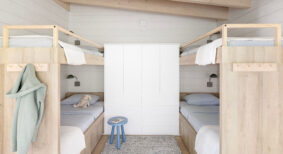There is significant opportunity and powerful financial incentive to reduce environmental impact related to energy consumption within the hospitality industry. Owners strive for efficient hotel lighting strategies, while guests desire comfortable spaces that are environmentally responsible.
Hotel owners, property managers and lighting designers are increasingly turning to LED technology for its energy-saving potential. In fact, according to a 2012 report by global management consulting firm McKinsey & Company, the LED adoption rate is expected to surge in the hospitality sector from 9 per cent today, to about 45 per cent by 2016. By 2020, it is expected to hit 80 per cent.
Why are people making the switch? Hotels are big business, comprising of more than 5 billion square feet of space in the U.S. alone. According to the U.S. Environmental Protection Agency, hotels spend more than $7.5 billion on energy each year. Lighting is accountable for a significant percentage of energy use. Energy-efficient LEDs can be used in nearly everywhere, from outdoor parking lots and signage, to lobbies, hallways, meeting rooms and guest suites.
Lighting affects guests’ perceptions of a space, whether they are aware of this fact or not. An analysis of design trends is a great place for hotel owners and designers to look when contemplating changes that might benefit both their guests and their bottom line.
LEEDing a new way
Hotels present a unique challenge in environmental performance given the constant demands of exceptional guest service. In 2008, the U.S. Green Building Council (USGBC) brought hospitality industry leaders together to identify areas of Leadership in Energy and Environmental Design (LEED) that could better address lodging facilities. Modifications to LEED credits produced by this process are reflected in the new restructured rating system, LEED v4.
Effective as of November 2013, the new requirements allow hotel owners to earn credits for conserving energy and creating healthier guest environments. And LEED-certified buildings give back, too. According to the USGBC, they cost less to operate, and reduce energy and water bills by as much as 40 per cent. LEED certification can also increase property values, and the buildings may qualify for a host of incentives like tax rebates and zoning allowances. Certification also articulates a commitment to sustainability to guests and stakeholders.
Lighting can be a key component of LEED projects, particularly in hotels, because of the sheer number of indoor and outdoor fixtures. Compared to other improvements, such as high-efficiency heating, cooling or plumbing systems, lighting tends to offer a faster payback at a lower cost — and with minimal disruption to guests. LEED v4 also allows hotel operators to earn credits for using lighting controls to optimize energy use throughout the day.
Return to simplicity
Clean, simple and elegant design is in. Some hotel design experts have expressed a belief that guests want little in the way of trendy aesthetics, and rather want more value for their money. As a result, some experts expect to see a shift toward simplified and seemingly sophisticated design that combines lighting and architecture as an art form. General Electric (GE) and USG Corporation recently joined forces to create an integrated LED lighting and ceiling system to create a more open, visually-appealing ceiling architecture that also combats over-lighting, showcasing the sort of thinking that will make simple and elegant easily attainable.
Tailoring to tomorrow’s traveller
Besides minimizing consumption of energy and making spaces look great, LED lamps can also help hotels and resorts attract a new generation of ‘ecotourists’ who are increasingly paying attention to environmentally-mindful operations. In fact, according to a recent Tripadvisor survey of 700 American travellers, 57 per cent said they often make eco-friendly travel decisions.
While there are many trends driving lighting design in the hospitality industry, hotel chains and locations must take their own unique considerations to heart when determining their lighting strategy.
Heather Wilson Coode is a hospitality marketing manager who has worked for GE Lighting for more than 15 years. She is responsible for developing strategic initiatives to help accelerate the adoption of energy-efficient lighting technologies within the hospitality industry.







